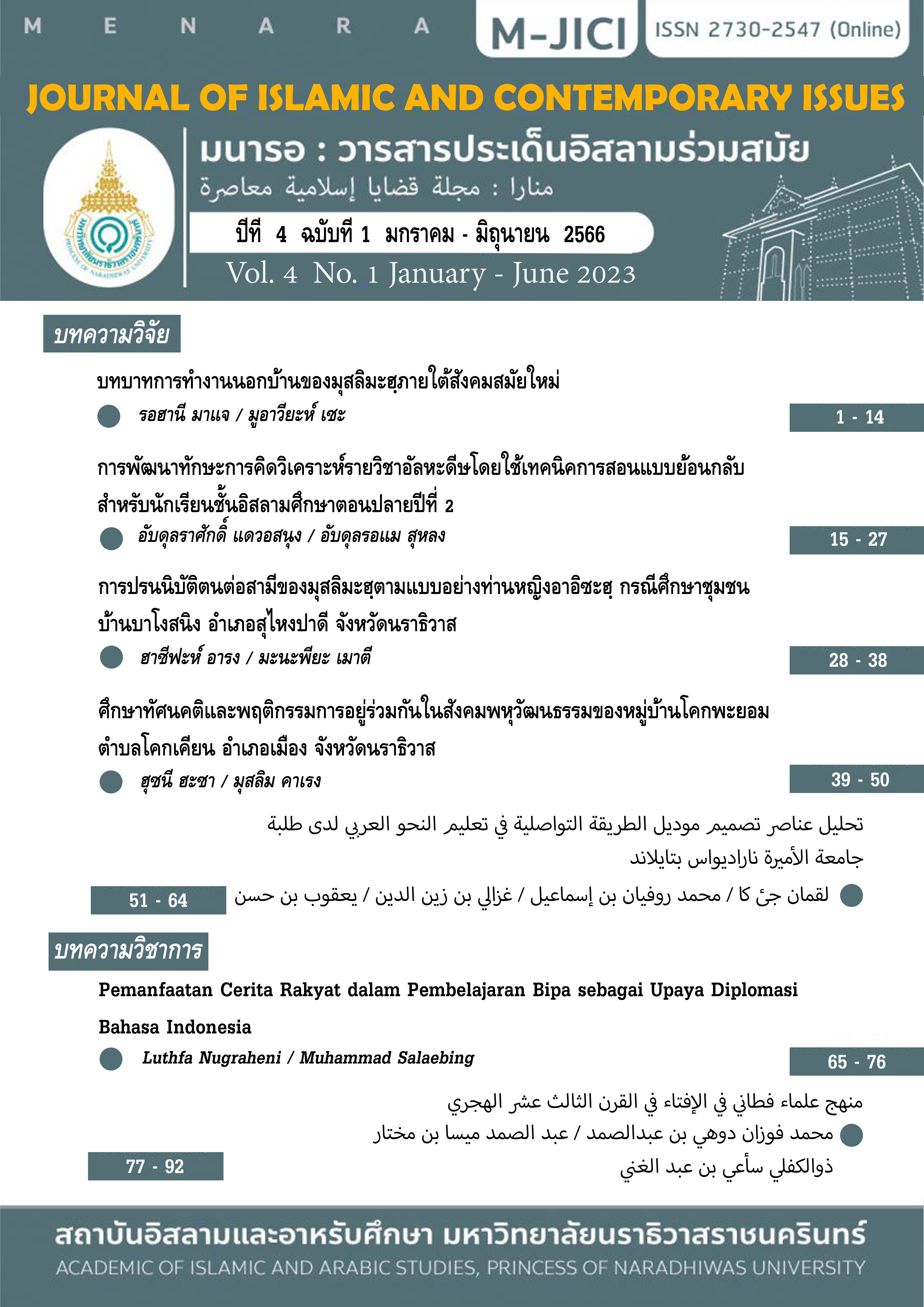The Development of Analytical Thinking Skill on al-Hadith Subject by Using Backward Design Technique for Secondary Islamic Studies Students, Year 2
Keywords:
Develop analytical thinking skills, al-Hadith subject, Backward designAbstract
The purposes of this research were to 1) develop and determine the efficiency of learning management on al-Hadith subject by using backward design technique for secondary Islamic Studies students, year 2 to the set criterion of 80/80, 2) develop analytical thinking skills on al-Hadith subject for secondary Islamic studies students, year 2 by using 70 % criteria, 3) compare the learning achievements on al-Hadith subject between before and after learning according to the learning management plans through reverse teaching, and 4)study the satisfaction towards the instruction by using backward design technique. The research instruments were 1) lesson plans by using backward design technique for secondary Islamic studies students, year 2 in the al-Hadith subject, 2) a test to measure the ability of analytical thinking skills for al-Hadith subject, 3) learning achievement’s test of al-Hadith subject, and 4) the satisfaction questionnaire towards instruction. The data was analyzed by percentage, mean, standard deviations. The research findings were as follows 1) the efficiency of the lesson plans on the development of thinking skill by using backward design technique for secondary Islamic studies students, year 2 was E1/E2 = 80.70/83.07, 2) the result of developing analytical thinking skills was 85.45 percent by comparing the criteria higher than the specified criteria
(70 percent), 3) the students learning achievement on al-Hadith subject after learning was higher than before learning which was considered statistically significant at the 0.05 level, and 4) the students’ satisfaction of learning management on al-Hadith subject by using backward design technique teaching, overall, was at a very satisfactory level ( =4.18, S.D. = 0.1).
References
กระทรวงศึกษาธิการ. (2546). หลักสูตรอิสลามศึกษา. กรุงเทพ : โรงพิมพ์องค์การรับส่งสินค้าและพัสดุภัณฑ์
เฉลิม ฟักอ่อน. (2552). การออกแบบการจัดการเรียนรู้แบบย้อนกลับ. กรุงเทพฯ : ประสานมิตร.
นงนุช อินทรกำแหงและคณะ. (2558). ผลการเรียนตามแนวคิดการออกแบบย้อนกลับผ่านเว็บเควสท์ที่มีต่อความสามารถในการคิดวิเคราะห์และผลสัมฤทธิ์ทางการเรียน ในรายวิชา เทคโนโลยีสารสนเทศและการสื่อสาร ของนักเรียนชั้นมัธยมศึกษาปีที่ 4. วารสารศึกษาศาสตร์ มหาวิทยาลัย มหาสารคาม, 9(2): 72-81.
บุญกนก ปิยะนิตย์. (2563). การพัฒนาชุดการเรียนการสอนด้วยกระบวนการจัดการเรียนการสอนแบบย้อนกลับ เรื่อง การใช้โปรแกรม Microsoft PowerPoint สำหรับนักเรียนชั้นประถมศึกษาปีที่ 6. วารสารการศึกษาและการพัฒนาสังคม, 15(2): 61-71.
ปรียะดา ภัทรสัจจธรรม. (2561). ประสิทธิผลของการออกแบบการเรียนการสอนแบบย้อนกลับเพื่อเสริมสร้างผลการเรียนรู้ตามกรอบมาตรฐานคุณวุฒิระดับอุดมศึกษาแห่งชาติของนักศึกษาพยาบาล. วารสารการพยาบาลและการศึกษา, 11(3): 64-78.
พลอยไพลิน ยิ้มสมบูรณ์ และคณะ. (2564). ผลสัมฤทธิ์ทางการเรียนและทักษะกระบวนการทางวิทยาศาสตร์ โดยใช้การจัดการเรียนรู้ตามการออกแบบย้อนกลับ เรื่อง การเปลี่ยนแปลงของอากาศของนักเรียนชั้นมัธยมศึกษาปีที่ 1. วารสารวิชาการคณะมนุษยศาสตร์และสังคมศาสตร์, 12(1): 30-40.
รสกรณ์ พลรัตน. (2557). การพัฒนากิจกรรมการเรียนรู้โดยใช้การออกแบบการเรียนรู้แบบย้อนกลับร่วมกับการประเมินด้วยแฟ้มสะสมผลงาน เรื่อง ทศนิยม และการบวก การลบ การคูณทศนิยม ชั้นประถมศึกษาปีที่ 6. วารสารวิชาการหลักสูตรและการสอน มหาวิทยาลัยราชภัฏสกลนคร, 6(16): 161-171.
ศุภรัก สุวรรณวัจน์และคณะ. (2555). การพัฒนาต้นแบบการเรียนการสอนผ่านสื่ออิเล็กทรอนิกส์โดยใช้การออกแบบย้อนกลับสาหรับหลักสูตรศิลปกรรมศาสตรบัณฑิต. วารสารวิชาการศิลปะสถาปัตยกรรมศาสตร์ มหาวิทยาลัยนเรศวร, 3(1): 126-136.
สถาบันทดสอบทางการศึกษาแห่งชาติ. (2562). รายงานผลการทดสอบระดับชาติขั้นพื้นฐาน I-NET ปีการศึกษา 2562 ชั้นอิสลามศึกษาตอนปลาย (ซานาวียะห์). ปัตตานี : สำนักบริหารงาน คณะกรรมการส่งเสริมการศึกษาเอกชน.
อับดุลเลาะ การีนา. (2549). มุศเฏาะละหฺอัลหะดีษ. ปัตตานี : วิทยาลัยอิสลามศึกษามหาวิทยาลัยสงขลานครินทร์.
สัมภาษณ์
อับดุลรอฮิม กาแบ อิบรอฮิม ตอปอและบัซมะห์ นิแว. ครูผู้สอนโรงเรียนอรุณอิสลามวิทยา. สัมภาษณ์เมื่อวันที่ 25 มิถุนายน 2563.
Downloads
Published
How to Cite
Issue
Section
License
Copyright (c) 2023 MENARA : Journal of Islamic and Contemporary Issues

This work is licensed under a Creative Commons Attribution-NonCommercial-NoDerivatives 4.0 International License.



